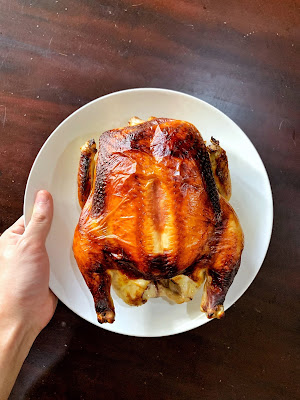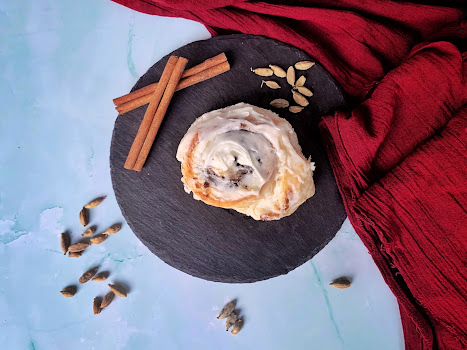I'm still trying to work out how it all started, but I've developed an obsession with using milk in my roasted meats. It all started when I read of Maiale al Latte, or milk-braised pork, an old Italian tradition that slow-cooks pork shoulder in milk, resulting in a tender hunk of pork swimming in a pool of creamy, almost-caramelised milk.
In a similar vein, I find myself enamoured with Samin Nosrat's way of roasting chicken, which uses buttermilk. The chicken soaks in the buttermilk overnight like a delicious spa, and the lactic acid in buttermilk works on the chicken meat. The resulting chicken? Perfectly-done and juicy, where the chicken breast is as supple as the thigh, and with a nice crackling skin.
I've been roasting chickens for years with mixed success. Like a rube, I first started by
just plonking a chicken straight into an oven and letting it cook, which turned out not great at all. I wizened up a little since then, and tried several ways of achieving roast chicken, from first boiling the chicken in seasoned chicken broth before transferring it into an oven (thanks Red Spice Road!), to spatchcocking (as recommended by Serious Eats). But this buttermilk process beats every other recipe hands-down for taste and convenience. It even adapts well to Christmas turkeys as seen below, though I could have left the turkey in the oven to brown for a bit longer. Also, I clearly could use some more carving practice.
INGREDIENTS
1.5 kg chicken
One day before roasting the chicken, season the chicken with salt and leave it for 30 minutes. For a 1.5kg chicken, about two teaspoons of fine sea salt would suffice. The wingtips can be removed and reserved to make chicken stock.
Stir 1 teaspoon of salt into the buttermilk. Transfer the chicken in a large ziplock bag, and pour in the buttermilk. Squeeze out as much air as you can, then seal the ziplock bag. Place the ziplock bag into a tray in case of leakage, and refrigerate for 24 hours. If you like, you can turn the bag every so often so every part of the chicken gets marinated, but that’s not necessary.
An hour before you like to roast the chicken, remove the chicken from the fridge. Preheat the oven to 220°C, with a rack set in the center position. Remove the chicken and scrap off the buttermilk. Place the chicken on a shallow roasting pan, breast side up, and place in the oven, with the thighs and legs oriented to the back half of the oven. When the chicken starts to brown, about 20 minutes, reduce the heat to 200°C and continue for another 30-40 mins, until the chicken is well browned and the juices run clear when you insert a knife down to the bone between the leg and the thigh.
Let the chicken rest for 10 minutes before carving and serving.
Tip: Making chicken stock
If 99% of internet recipes are to be believed, making chicken stock sounds like a tedious and expensive process. Well, it doesn't have to be, and you can put that fennel right down. Making chicken stock is a great way to get the last bit of flavour from the roasted chicken after you're done with the meal, and no, you don't need a bag of chopped carrots either. In the can-do spirit of this article, written by a cookbook coauthor and as someone who has things to do aside from cooking, all you need is a chicken carcass and a pot of water, where you boil the chicken for the time it takes for you [to watch an episode of Succession].













